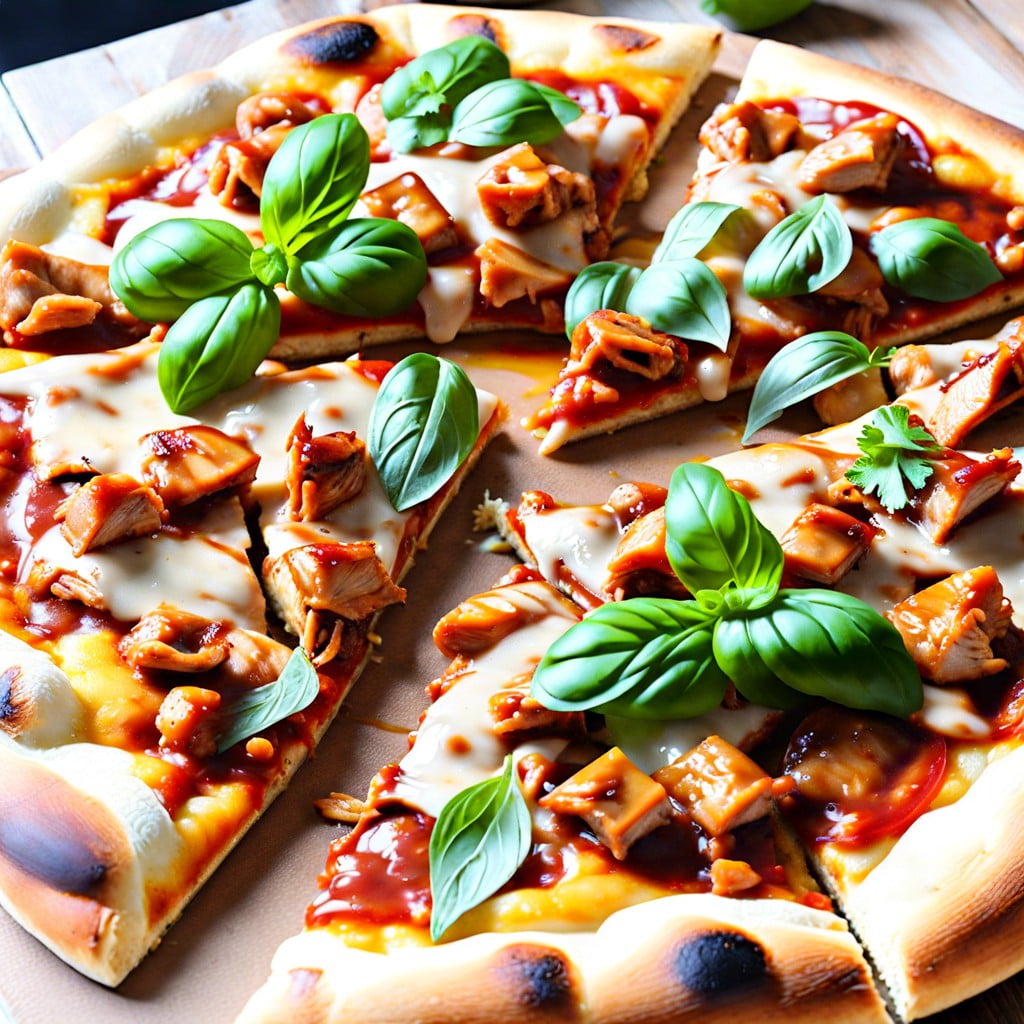Learn how to elevate your next pizza night by mastering the art of making BBQ chicken pizza, infusing traditional pie with smoky, savory flavors.
Key takeaways:
- Craft your own BBQ sauce for a distinctive flavor.
- Select boneless, skinless chicken breasts or thighs for grilling.
- Use room temperature dough and stretch it without a rolling pin.
- Layer the pizza with sauce, cheese, chicken, and toppings.
- Bake at 475°F (245°C) for 9-12 minutes, rotating halfway through.
Homemade BBQ Sauce

Crafting your own BBQ sauce establishes a distinctive flavor foundation for your chicken pizza. A balanced sauce harmonizes sweetness, tanginess, and heat, typically achieved by using ketchup as a base, sweetened with molasses or honey, and adding apple cider vinegar for acidity. Complexity is infused through a dash of Worcestershire sauce and a sprinkle of smoked paprika, which mirrors the subtle smokiness of grilling. For a personalized touch, consider incorporating ingredients such as brown sugar for deeper sweetness, Dijon mustard for a sharp bite, or a hint of cumin for an earthy undertone.
The key to a successful BBQ sauce lies in the simmer. Gentle heat allows flavors to meld and the sauce to thicken to the desired consistency, ensuring it clings perfectly to both the chicken and the pizza crust. Homemade sauce can be adjusted for spiciness; red pepper flakes or hot sauce can be titrated to taste. Remember, the sauce should complement the chicken, not overpower it.
Preparation of Chicken for BBQ
Selecting the right cut is crucial; boneless, skinless chicken breasts or thighs are preferred for even cooking and easy eating.
Prior to cooking, marinate or brine the chicken to infuse flavor and moisture.
Grill the chicken over medium heat to achieve a charred exterior without drying out the interior.
Allow the chicken to rest before dicing it into bite-size pieces to ensure those flavorful juices stay locked in, enhancing your pizza topping.
For those looking to cut down on time, a rotisserie chicken from your local grocery serves as a swift and flavorful alternative, easily shredded for convenience.
Stretching and Shaping Pizza Dough
Begin with dough at room temperature to enhance pliability. Dust a clean surface with a light layer of flour to prevent sticking, and gently flatten the ball of dough with your fingertips. Start from the center and push outward, encouraging the dough to expand without tearing. To create a traditional crust, leave a small, thicker edge around the circumference.
For stretching, lift the dough onto your knuckles, letting gravity gently pull it into a larger circle. Rotate consistently to ensure an even shape. If the dough springs back, it may need a few more minutes to rest and relax the gluten.
Avoid using a rolling pin, as this can compress the dough, potentially leading to a denser, less airy crust after baking. If holes form, simply pinch the dough back together. Aim for a uniform thickness that will cook evenly, remembering that overly thin areas may lead to breakage once toppings are added.
Assembling BBQ Chicken Pizza
Begin with a pre-baked or fresh pizza base, ensuring an even distribution of sauce, leaving a small border for the crust. Layer with a moderate quantity of mozzarella to prevent sogginess, followed by the precooked chicken pieces.
Additional toppings like red onion and cilantro can augment the flavor profile. Thread sliced smoked gouda throughout, as it melds well with BBQ flavors, offering a smoky undertone.
For an even cook and a picturesque top, be mindful not to overload the pizza. Optionally, a final drizzle of BBQ sauce can amplify the taste and add visual appeal. Remember, balance is key to allow each component to shine.
Baking Temperature and Time
Precision in baking is pivotal for a flawless finish. Aim for a preheated oven at 475°F (245°C) to ensure a crisp crust without overcooking the toppings.
Timing is typically between 9 to 12 minutes, but keep a keen eye out for a golden-brown crust and bubbling cheese.
A pizza stone can enhance the cooking process by distributing heat evenly, so consider using one if available.
Rotate the pizza halfway through for uniform cooking, and if the toppings require more heat, utilize the broiler for a minute or two at the end, watching closely to prevent burning.

